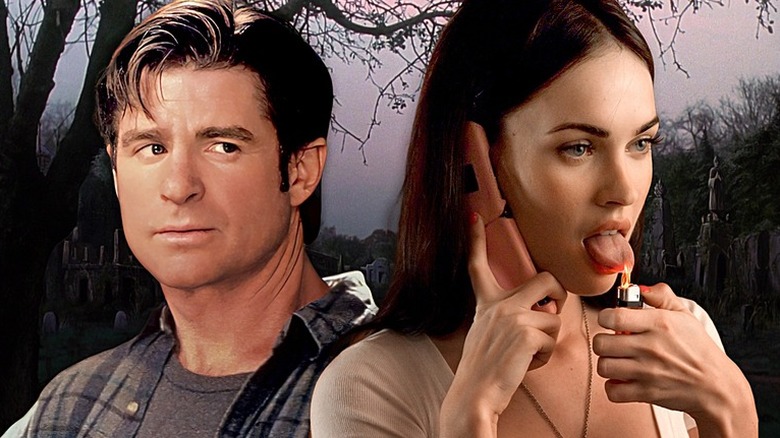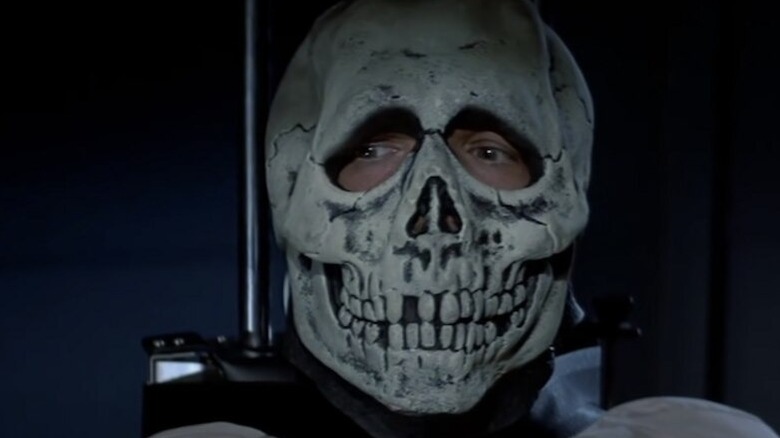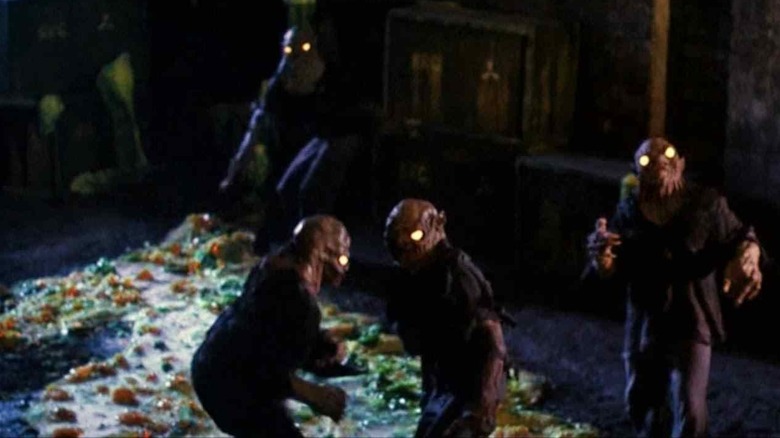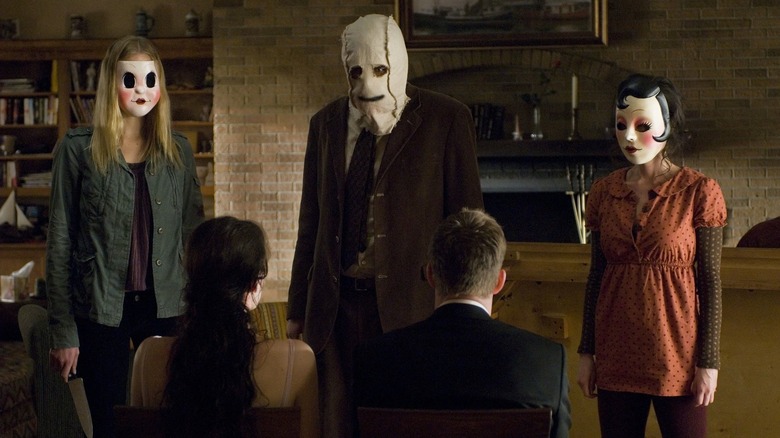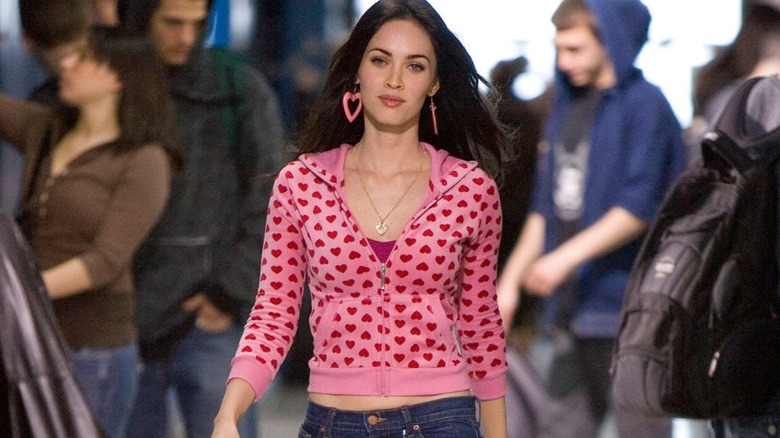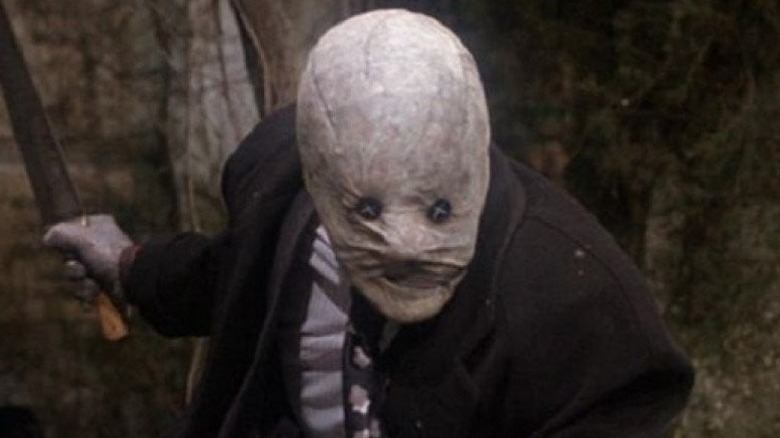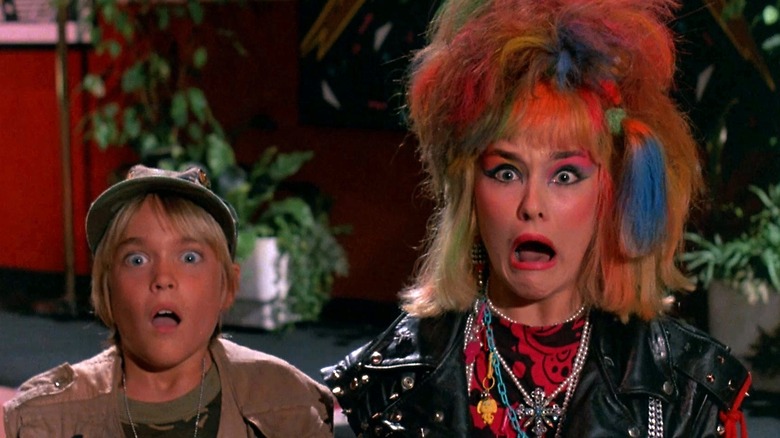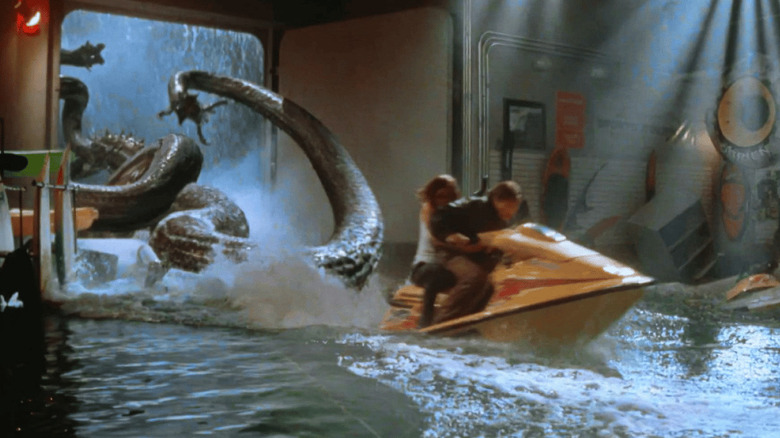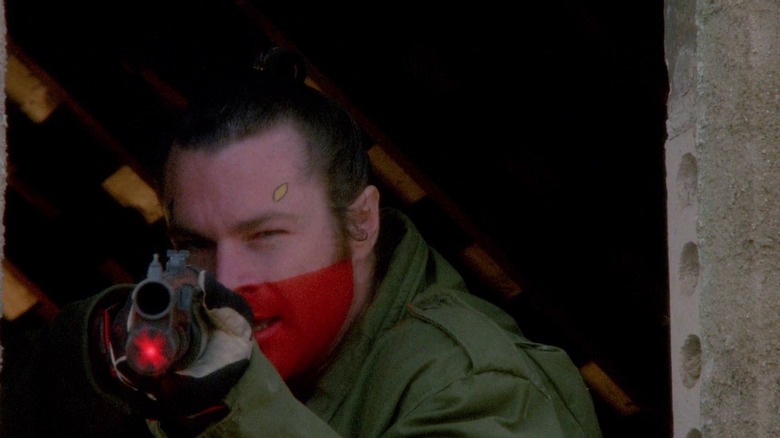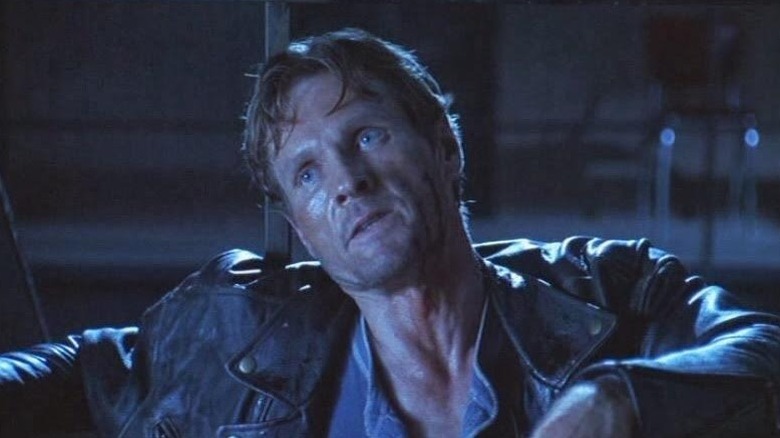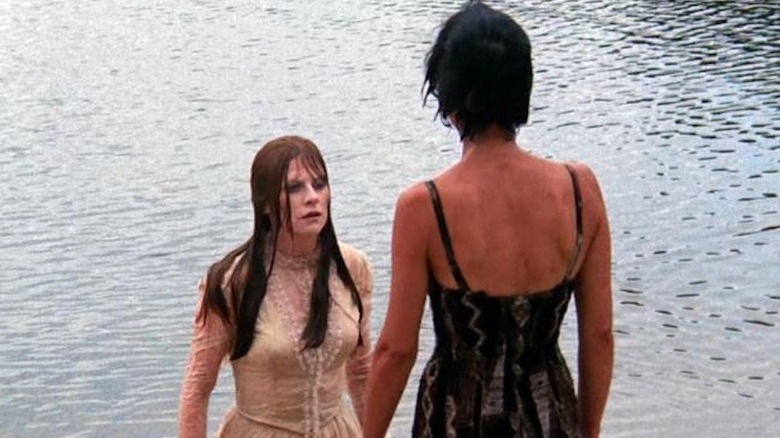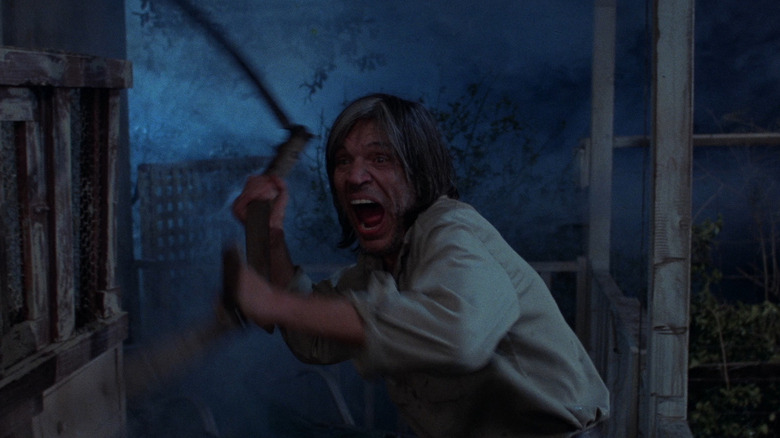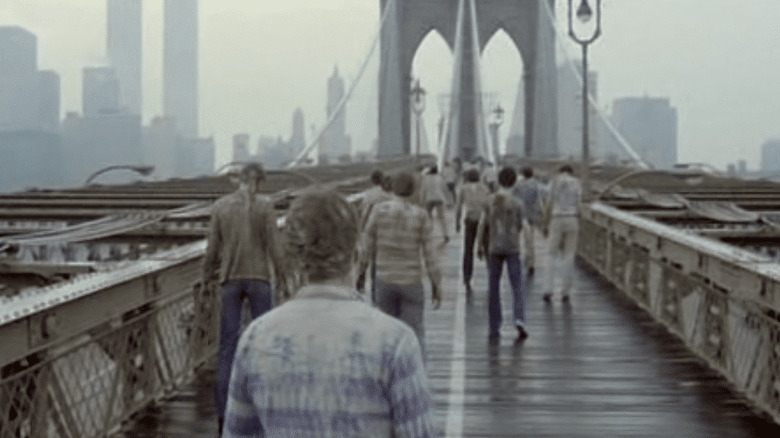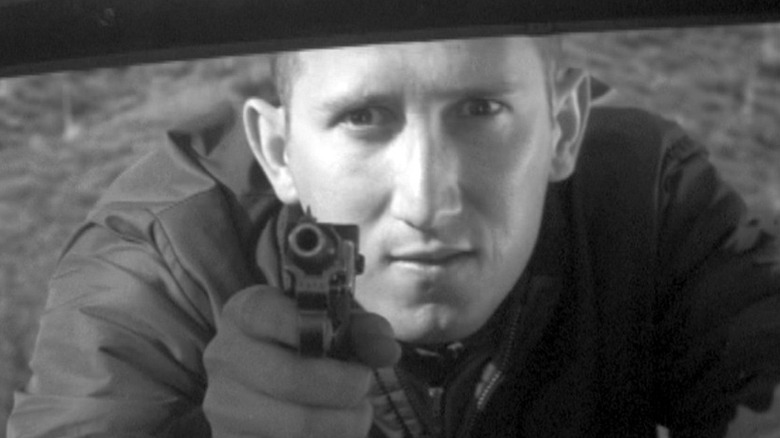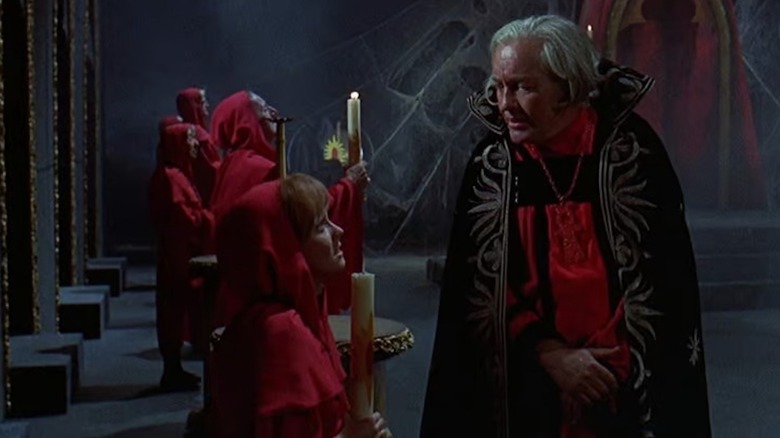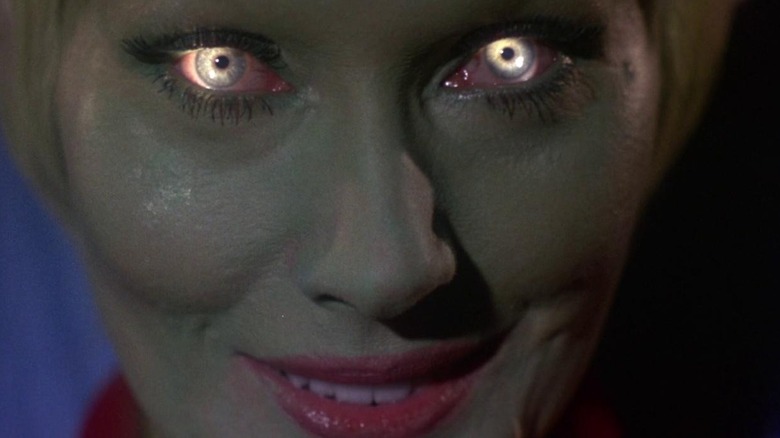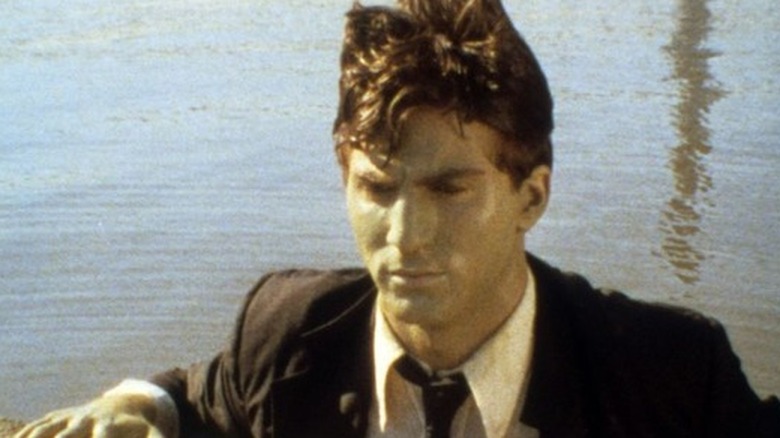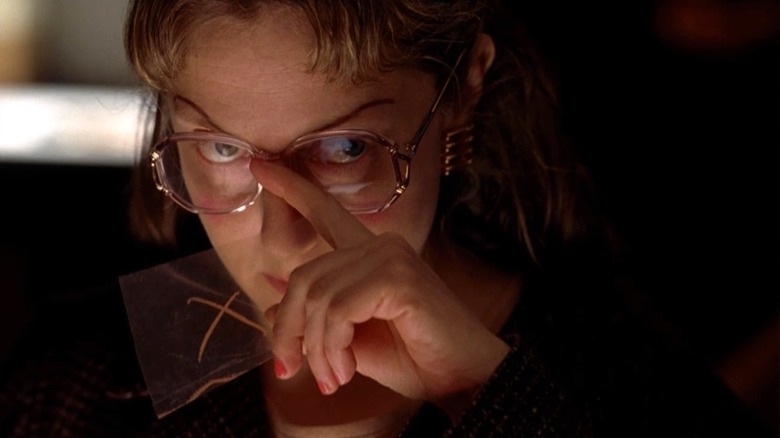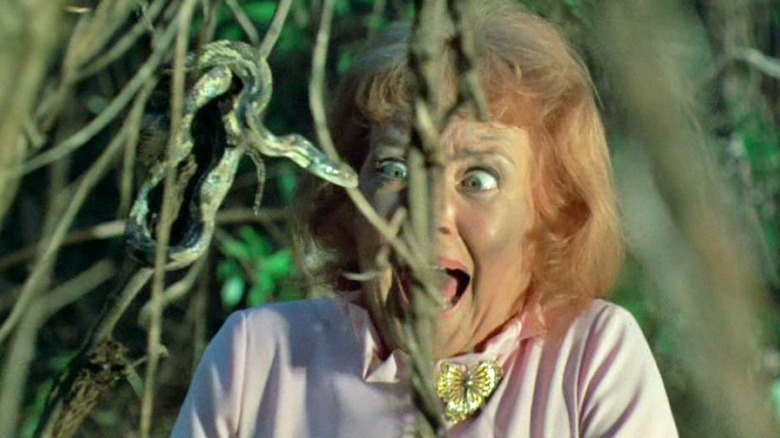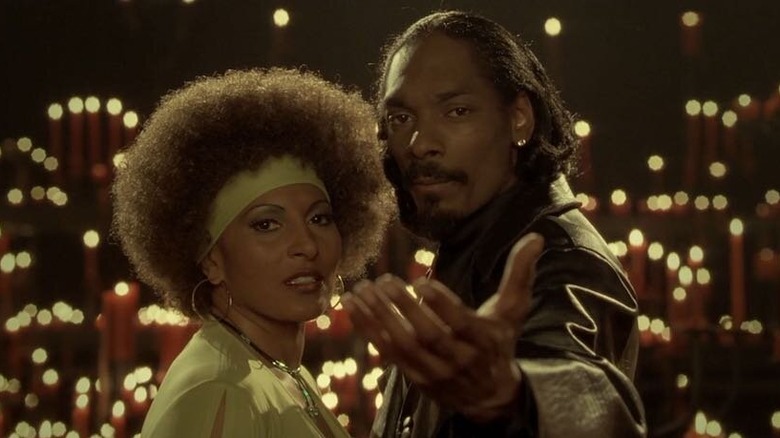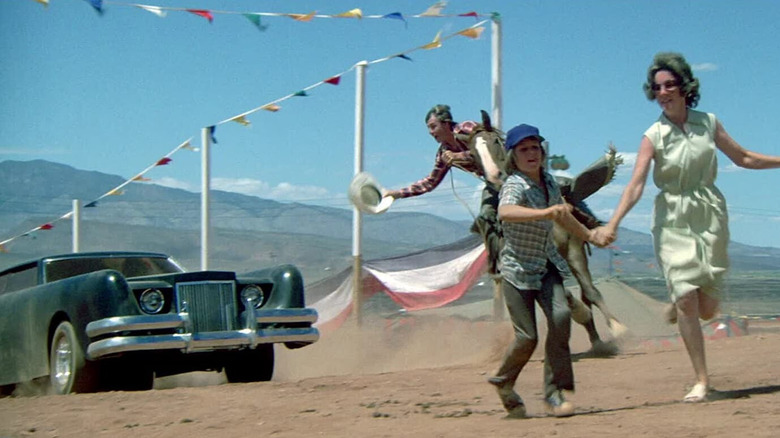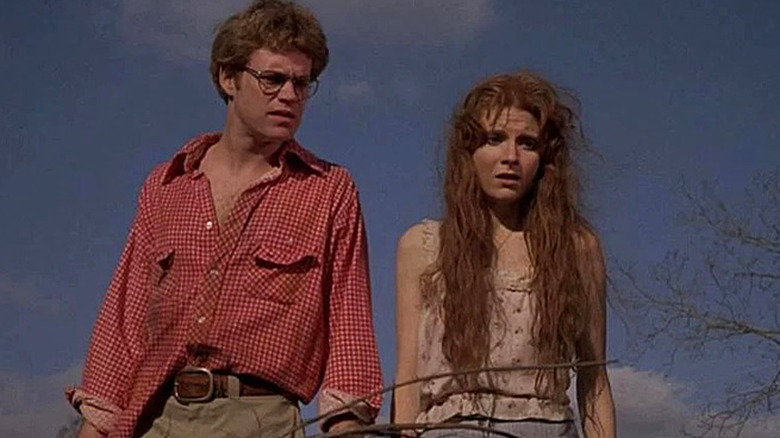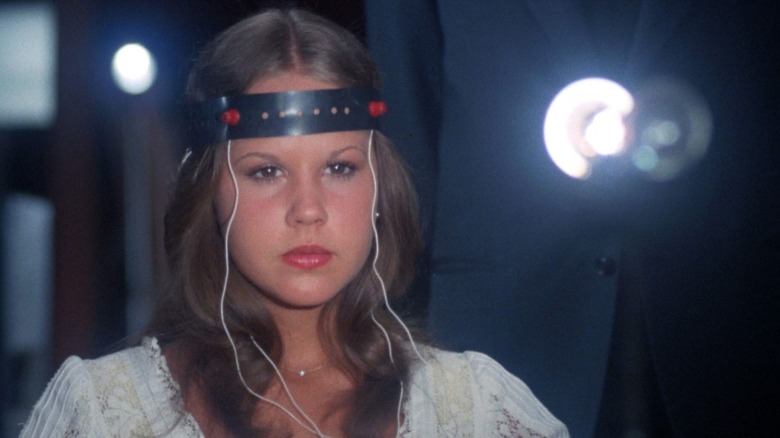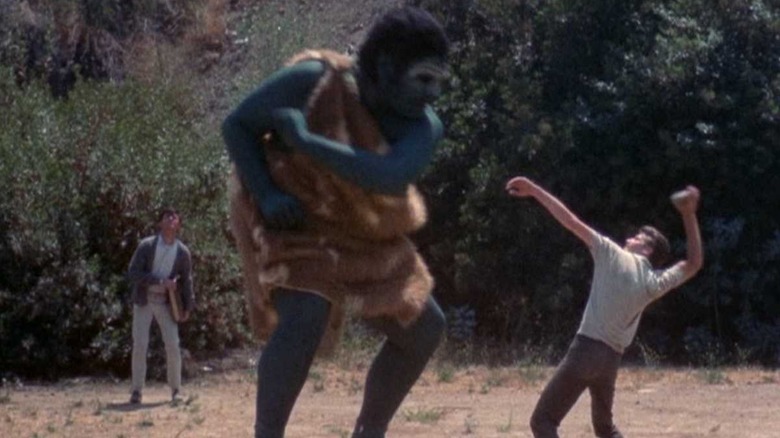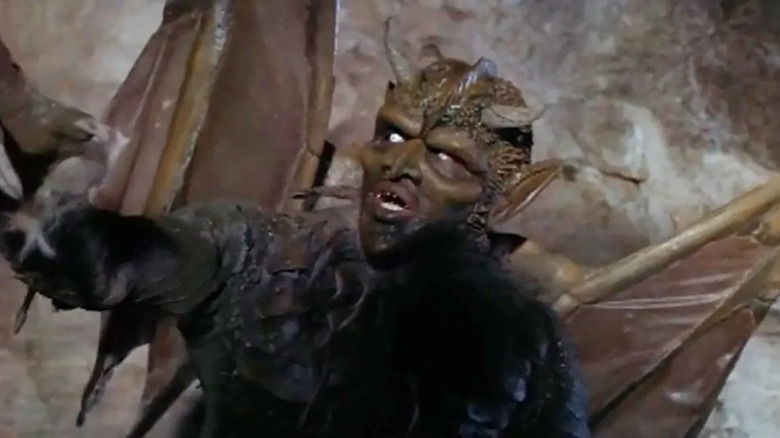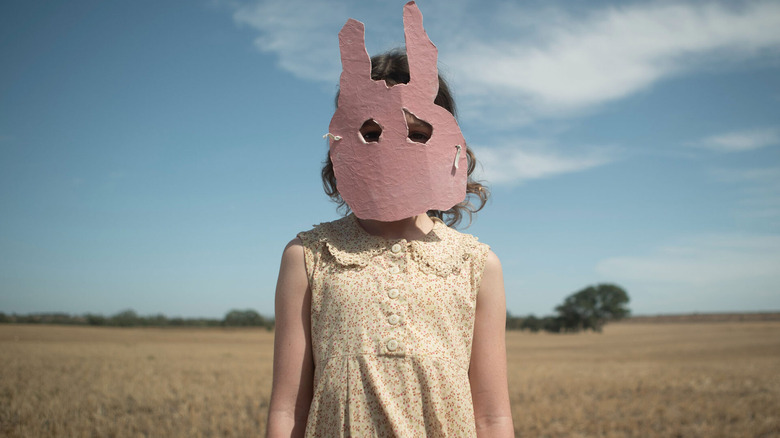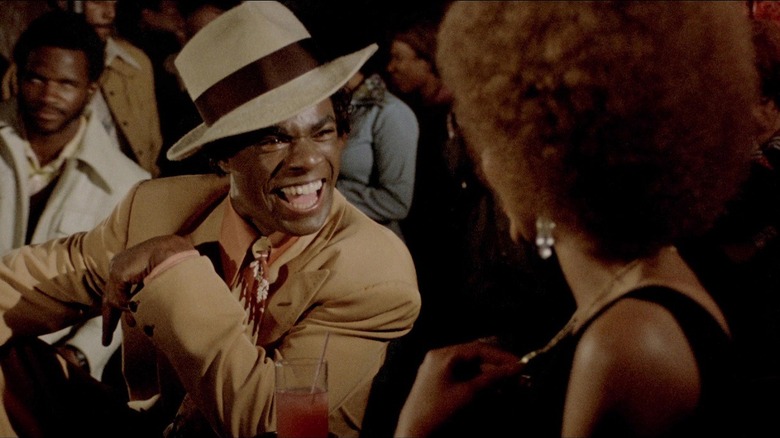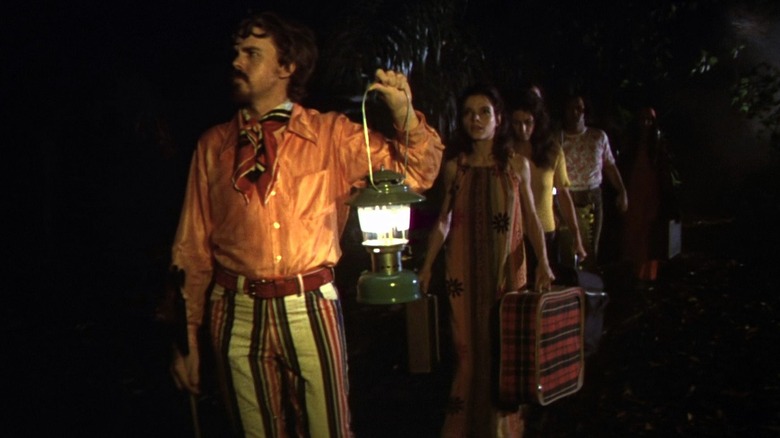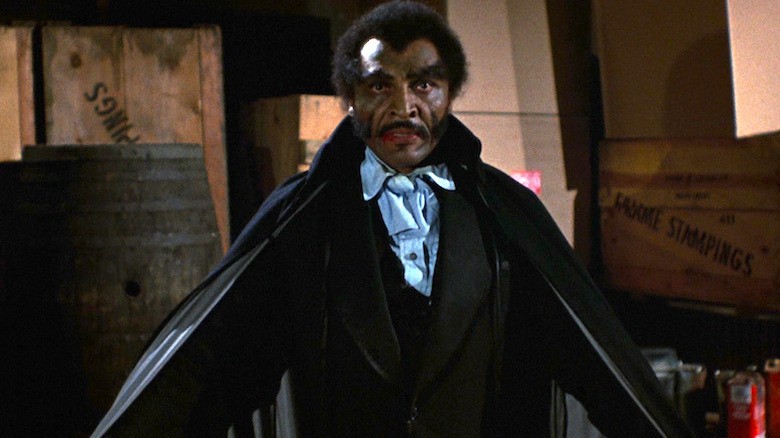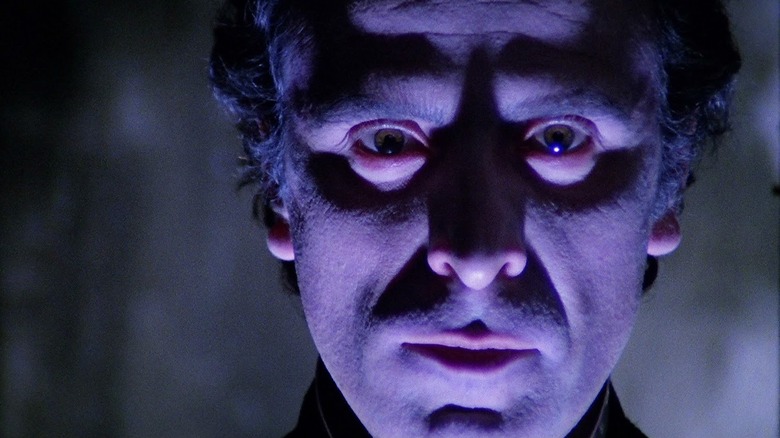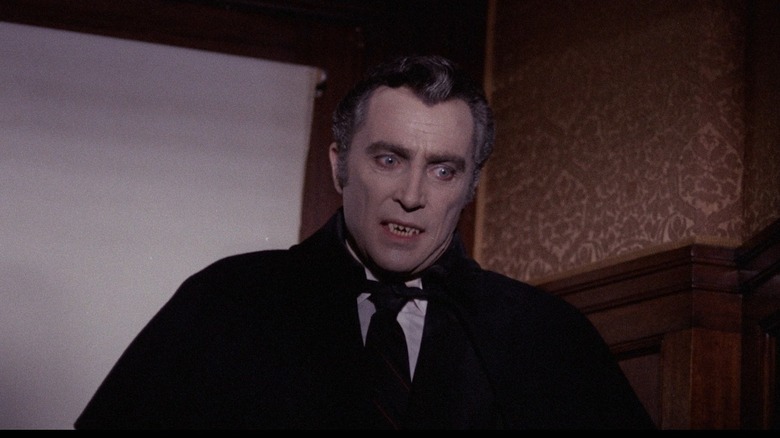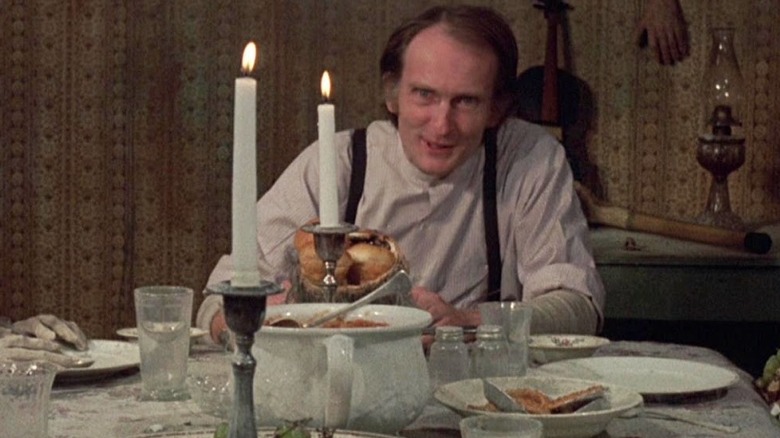Horror Movies With Terrible Rotten Tomatoes Scores That Are Actually Worth Watching
Like all movie ranking sites, Rotten Tomatoes likes to post its own "best of" lists of film genres, and horror movies are no exception. Its list of what it considers the 200 Best Horror Movies is, for the most part, unimpeachable: you'll find the 1931 "Dracula" alongside "Alien" and even recent releases like "Barbarian" in its ranking. But as you scroll through the 200 titles, chances are, you'll find titles that might give pause for their inclusion: Does "Zombieland" really merit being placed above classics like "The Birds" and "The Innocents"? And even though it resides at No. 169, "Saw X" — really?
All this is to say that movie rankings, no matter the genre, are highly subjective, and one person's classic is another person's trash. A scan of Rotten Tomatoes' horror listings bears out that notion: There are dozens, if not hundreds, of fright films that reside far down on the Tomatometer but have ardent fanbases and have been rediscovered since their initial releases. Here is a list of horror films that, despite their lousy ranks on Rotten Tomatoes, are more than worth your time.
Halloween III: Season of the Witch
In an interview for Yahoo! Movies, "The Guest" screenwriter Simon Barrett summed up the reaction of audiences to "Halloween III: Season of the Witch" upon its release and the three-decade about-face that transformed the film into a cult favorite. "I saw 'Halloween III' when I was 10 or 11, during that period when I'd rent everything from the horror section in the video store," he recalled. "I watched it with a couple of friends, and they were like, 'This is bulls***! Where's Michael Myers?' Then you get to the end, and you think, 'Wait, that was actually pretty cool!'"
Released to negative acclaim and tepid box office returns in 1982, "Halloween III" was blasted for its bizarre storyline: A Halloween mask company owner (Dan O'Herlihy) implants fragments of Stonehenge in his products to sacrifice children for ancient rituals. Audiences and critics disliked its downbeat ending and, most importantly, its lack of Michael Myers, despite John Carpenter and Debra Hill returning as producers.
While it seems like some audiences are still unhappy over that omission — resulting, perhaps, in its 50% critic rating and 29% audience score on Rotten Tomatoes – others find its mix of chills and cracked conspiracy theories a satisfying horror experience, even without Michael Myers. As director Tommy Lee Wallace told Yahoo!, "'Halloween III' found its audience. There are a lot of us out there who think it's a pretty darn good movie."
C.H.U.D.
It's possible that you may have heard a reference to "C.H.U.D" in episodes of "The Simpsons" or "Ricky and Morty" (or some highly contentious memes); you might have also caught a glimpse of a "C.H.U.D" VHS tape in the opening frames of Jordan Peele's "Us." "C.H.U.D." refers to Cannibalistic Humanoid Underground Dwellers, as well as the 1984 film of the same name, which featured a pre-"Home Alone" team-up of John Heard and Daniel Stern, who discover that chemical waste has turned members of New York's unhoused population into monsters. Watch carefully, and you'll also see John Goodman and Jay Thomas as cops and Patricia Richardson of "Home Improvement" in the cast.
If that premise sounds like pure B-movie fodder, it is, and most likely, it's also why "C.H.U.D." enjoys a 29% rating on Rotten Tomatoes. However, it's developed a cult following over the past three decades as a taut, suspenseful, and surprisingly smart thriller that also happens to feature sewer-dwelling monsters. The New York Times supported it back in 1984, with writer Lawrence Van Gelder noting its "knowing feel for the atmosphere of New York City, occasional flashes of wit in the script by Parnell Hall, and commendable restraint ... in the administration of the requisite doses of monsters."
The Strangers
What's the deal with the middling response for "The Strangers"? The 2008 thriller from Bryan Bertino, about a couple terrorized by a trio of masked intruders, was a modest hit upon release and enjoys a cult following today. It's even spawned a franchise with "Strangers: Prey at Night" and a new trilogy from Lionsgate. With that longevity, why does the original "Strangers" only rate 49% on Rotten Tomatoes? The most likely answer is negative reviews from squeamish critics, who found the psychological games played by the Strangers unpleasant, like NPR's Bob Mondello, who called it a "sadistic, unmotivated home-invasion flick."
"The Strangers" is intense, but its reputation is built on its nerve-rattling suspense and the horror of its premise, which was reportedly inspired by disturbing real-life events. The actual gore is surprisingly low, so if that's the factor keeping you from watching the film, put your worries aside. You should be prepared, however, to remain on the edge of your seat for the full running time; as Michael Rechtshaffen with The Hollywood Reporter noted, it's a "spare, creepily atmospheric psychological thriller with a death grip on the psychological aspect."
Jennifer's Body
"Lisa Frankenstein" screenwriter Diablo Cody's first foray into horror, "Jennifer's Body," has finally found its audience despite a dismal box office performance. Shortly after winning the 2007 Oscar for her script for "Juno," Cody wrote this 2009 horror-comedy about a nerdy high schooler (Amanda Seyfried) who discovers that her popular friend (Megan Fox) was murdered and then possessed by a ravenous demon with an appetite for male suitors. As with Cody's "Lisa Frankenstein," critical and fan response to "Jennifer's Body" was mixed, and its current Rotten Tomatoes score is a lukewarm 46%.
Don't let that scare you off from seeing "Jennifer's Body." The film has enjoyed critical and fan reappraisals in the past decade, especially during the #MeToo movement: as Constance Grady noted for Vox, "What 'Jennifer's Body' offers up in response to the trauma and tragedy of what happened to Jennifer ... is the cathartic fantasy of what happens next, of Jennifer turning her trauma against her attackers, of her using her victimized, violated body to wreak bloody vengeance on the patriarchy." Fans of Cody will be interested in some Easter eggs that even suggest a "Jennifer's Body"/"Lisa Frankenstein" cinematic universe.
Nightbreed
1987's "Hellraiser" marked novelist Clive Barker as a major figure on the rise in horror movies. However, that ascent was cut short with his second film, 1990's "Nightbreed." Barker's story is a fantasy-horror hybrid about a troubled man (Craig Sheffer) who flees the influence of his serial killer therapist (David Cronenberg) for an underground community of monsters. The film baffled 20th Century Fox, which forced Barker to trim nearly an hour from his cut and released it without critical previews. As a result, "Nightbreed" flopped, and the truncated version sits at 53% on Rotten Tomatoes.
Barker's fervent wish for the release of his original edit came to pass in 2014 with a Blu-ray release from Shout! Factory. That's the version that's worth seeing: It reduces Cronenberg's presence and offers an intriguing conclusion that foreshadows Barker's intention to form a trilogy around "Nightbreed." The Director's Cut also places greater emphasis on the Nightbreed themselves, transforming them into full-fledged characters. Recently, critics have praised the story as an effective allegory for the queer community. "The director's cut allows us more time with the creatures and ups their number, emphasizing that they're only fearsome to those afraid of difference," wrote Charles Bramesco for The A.V. Club.
TerrorVision
The 1986 horror-science fiction comedy "TerrorVision" has a 10% rating on Rotten Tomatoes, which generally suggests a truly terrible film. That's a harsh verdict for director Ted Nicolaou and Empire Pictures, which gave us "Troll" and "Ghoulies," but also the classic "Re-Animator." "TerrorVision" sits somewhere between those two poles: Its story, about a TV-obsessed family whose new satellite antenna brings a hungry alien to Earth, is steeped in cheap gags and special effects, but also manages to be genuinely funny (though very un-PC) and unexpectedly clever and even takes a few shots at '80s consumerist culture.
Any success enjoyed by "TerrorVision" is due to its cast of cult favorites like Gerrit Graham, Mary Woronov, Robert Altman regular Bert Remsen, and Diane Franklin, as well as a pre-"Napoleon Dynamite" Jon Gries. All seem to embrace the broad humor of Nicolaou's script and invest it with vibrant energy. The writers deliver low-brow gags — gloppy aliens, buxom horror movie hosts — for the grindhouse-minded but also wisely skewer the family for being so stupid that they not only invite the alien into their home but also blow their chance to defeat it. "This bright, kooky, and hilarious movie accomplishes exactly what it sets out to do," wrote Jessica Scott for Certified Forgotten, "and it does so in an eminently engaging and entertaining way that has earned it a well-deserved cult status."
Deep Rising
Shortly before striking box office gold with "The Mummy" in 1999, Stephen Sommers wrote and directed 1998's "Deep Rising," a modestly budgeted science fiction-horror film. A host of negative reviews — including one by Roger Ebert, who later featured it on his Most Hated list — sank the film upon release, so you aren't to be faulted if you haven't heard of it. However, if you liked the action, creature feature thrills, and humor in "The Mummy," you'll enjoy "Deep Rising" as well — despite its 34% Rotten Tomatoes rating.
Like "The Mummy," "Deep Rising" follows a blueprint from classic Hollywood and B-pictures: There's a fast-talking hero (Treat Williams) and a clever heroine (Famke Janssen), a host of bad guys (including Wes Studi, Anthony Heald, and Djimon Hounsou), and an insurmountable monster: a colossal, Lovecraftian sea creature with a taste for passenger ships. The dialogue is breezy, the action briskly paced, and the monster scenes appropriately gross.
If there's an issue with "Deep Rising," it's the budget, which can undermine its special effects and production design. If you can see past that, you'll most likely agree with Ty Burr's assessment for Entertainment Weekly: "It's pretty darn wonderful — a tightly written, often howlingly funny 'Aliens' knockoff that, in its portrayal of tough men and tougher women under pressure, favorably recalls the work of Howard Hawks."
White of the Eye
The 1987 thriller "White of the Eye" is not easy to watch or digest. It's the penultimate film from Scottish cult director Donald Cammell, who rose to fame in 1970 with the disorienting "Performance," which featured Mick Jagger as a mysterious pop singer. All of Cammell's films play with issues of reality and perception, often through hallucinatory film techniques (editing and music, in particular), and "White of the Eye" is no exception.
"White of the Eye" is at first a film about a serial killer murdering women in a ritualistic fashion, and in that regard, it's absolutely harrowing (one murder involves the killer forcing his victim to watch her own death). It blossoms into an obsessive triangle among a sound engineer (David Keith), his wife (Cathy Moriarty of "Raging Bull"), and her ex-husband (Alan Rosenberg), which unfolds in numerous dizzying flashbacks.
The structure of the film is most likely the reason for the middling 50% rating on Rotten Tomatoes, but in a decade filled with cheap slashers, Cammell's extraordinary visuals and violence reward adventurous horror fans. As Graeme Clark of The Spinning Image noted, "There are few serial killer films that would be brave enough to take Cammell's approach, and that's what distinguishes this work: there's nothing exactly like it."
Tales from the Crypt: Demon Knight
The first of two official theatrical movies spun off from HBO's "Tales from the Crypt" series (2002's "Ritual" was repackaged as a "Crypt" movie), "Tales from the Crypt: Demon Knight" stars William Sadler as a drifter who fends off the demonic Collector (Billy Zane) with a sacred artifact. Loaded with gory violence and special effects, "Demon Knight" was dismissed upon release. But it's not short on talent, with acclaimed cinematographer Ernest Dickerson as director and a cast that included Jada Pinkett, CCH Pounder, and Thomas Haden Church.
Its 42% rating on Rotten Tomatoes doesn't do "Demon Knight" justice. If you're looking for the same level of carnage as the best episodes of the "Crypt" series, it absolutely delivers: Heads and limbs are torn from bodies, and demons are blown apart with abandon. It's also true to the dark humor and hyper-stylized aesthetic of the '50s horror comics on which the series was based: as The New York Times noted, "What 'Tales from the Crypt' does best is sustain a look and tone that bring a comic-book's broad strokes into the realm of a live-action movie without seeming too mannered or arty." Most importantly, it's way better than the second "Crypt" movie, "Bordello of Blood."
Let's Scare Jessica to Death
One faction of horror fans wants their scares served up without any illusions and preferably raw and bloody. But another section of that demographic understands H.P. Lovecraft's declaration that the oldest and strongest kind of fear is the fear of the unknown and relishes horror movies that require patience when doling out scares. The former group is likely responsible for the underrated '70s horror movie "Let's Scare Jessica to Death" earning a 36% rating on Rotten Tomatoes.
The film, which concerns a psychologically fragile woman (Zohra Lampert) beset by a vampire and its lumbering servants, trucks in lingering, surreal frights over buckets of blood. If that's not your cup of chills, "Jessica" will be a disappointment. But if your brand of horror doles out scares in tantalizing increments, be prepared to be rattled by "Let's Scare Jessica to Death." As esteemed critic and author Kim Newman told Love Horror, "It was the first film to deliver on the promise of the X certificate, of grasping the heart and mind with icy fists, leaving a permanent impression on the psyche."
Eaten Alive
Much of the reason behind the 35% rating on Rotten Tomatoes for Tobe Hooper's "Eaten Alive" is due to what it's not rather than what it actually is. The 1976 film is not Hooper's intensely disturbing masterwork, "The Texas Chain Saw Massacre." "Eaten Alive" has more polish than its predecessor: It was filmed on a Hollywood soundstage, stars veteran Hollywood actors like Neville Brand and Carolyn Jones (as well as a young Robert Englund), and features a tone similar to the dark, "sick" humor of '50s-era horror comics. Audiences didn't like it, and even Hooper abandoned the film over conflicts with the producers.
But "Eaten Alive" has its own barely controlled energy that makes it worth a second look. The soundstage allowed Hooper to experiment with surreal lighting — sickly pinks and crimson reds — that roots the film somewhere between "Tales from the Crypt" and experimental theater. The huge cast of characters all seem on the verge of an anxiety attack as they attempt to kill or be killed; Brand's greasy lunatic, in particular, can't stop screaming about the crocodile that lives under his backwoods motel or cleaning its filthy rooms. As Stephen Thrower noted in "Nightmare USA" (via Acidemic), "In all its malformed glory it still commands respect for its unrelenting weirdness, its vicious hysteria, and Neville Brand's wonderful performance."
Zombie
Lucio Fulci's "Zombie" (aka "Zombi 2") only rates 41% on Rotten Tomatoes – a surprisingly low rank for a film widely regarded by horror fans as one of the bloodiest and most shocking entries in the cycle of European carbon copies of George Romero's "Night of the Living Dead" and "Dawn of the Dead." (In fact, 1979's "Zombie" was marketed as a direct sequel to "Dawn" in Italy). "Zombie" had everything for the grindhouse and drive-in crowd: gruesome special effects, a fatalistic, no-way-out ending, and a memorable U.S. ad campaign anchored by the tagline "WE ARE GOING TO EAT YOU!" Yes, the effects and performances are sometimes primitive compared to modern zombie films, but again: 41%?
Phelim O'Neal for The Guardian wrote, "['Zombie'] delivers, plain and simple. You want gore? You want zombies? Then you'll want this film. ... Fulci's once banned 'video nasty' is perhaps the ultimate undead movie, making up in quality what it lacks in quantity." While it lacks strong, relatable characters and grand world-building, "Zombie" is nevertheless one of the best zombie movies you've probably never heard of. It's pure exploitation, designed solely to disgust and/or amuse. But it does have waves of remorseless zombies, a death-knell synth score by Fabio Frizzi, and (literally) eye-popping special effects, including a stuntman in zombie makeup fighting a real shark underwater.
The Thrill Killers
If you know the cult indie director Ray Dennis Steckler at all, it's probably because of guilty pleasure horror films like "The Incredibly Strange Creatures Who Stopped Living and Became Mixed-Up Zombies," which veers from melodrama to horror to musical, often within the same scene. Steckler made films very quickly and for very little money, and the eccentricity of his output was a chief selling point. They aren't very good by Hollywood standards, but there was (and remains) nothing else like them. But Steckler could, under the right circumstances, turn out a film with mainstream appeal, such as his 1966 shocker "The Thrill Killers."
"The Thrill Killers" features Steckler's hallmarks: strange forays into other genres, a fragmented plot, and curious directorial choices determined by budgetary restraints. That explains its Rotten Tomatoes audience rating of 36% and two "Rotten" reviews out of three total. But once the film focuses on a couple (Joseph Bardo and Liz Renay, later the star of John Waters' "Desperate Living") caught between a psychopathic killer (Steckler) and three escaped mental patients — it becomes surprisingly suspenseful, thanks to stark black-and-white photography and the unfettered performances of the villains.
Of course, Steckler can't completely reel in his odd aesthetic — the film ends with a motorcycle/horse chase — but as genre critic Nathaniel Thompson noted for Mondo Digital, "[This] film is shot far more skillfully than you'd expect with a handful of really fascinating visual touches scattered throughout."
The Brotherhood of Satan
The title of 1971's "The Brotherhood of Satan" suggests a lurid occult thriller for the grindhouse crowd, with fiery rituals and bloody human sacrifice. What this obscure independent feature directed by TV vet Bernard McEveety offers instead is a Southwest Gothic: a fog-laden, shadow-steeped nightmare set in a California desert town where the children are disappearing and their parents are murdered by unseen hands. A Satanic cult is at work here, a coven led by kindly Doc Duncan (Strother Martin), whose plans for the children involve a more macabre fate than simple sacrifice.
A slow-boiling chiller that ends on an ambiguous note isn't going to fire up a significant portion of the horror crowd, which probably accounts for the film's 13% rating on Rotten Tomatoes. But the dreamlike pace and lack of answers — conceived by co-writers/co-producers L.Q. Jones, a veteran of Sam Peckinpah's Westerns, and "Green Acres" star Alvy Moore — as well as an atmosphere steeped in paranoia, leave a lasting impression on those willing to take the ride with "Satan."
Few reviewers in 1971 praised the film, which has since found a cult audience But as the New York Times stated, "The film displays bold, direct, relatively uncomplicated acceptance of its supernature that seems the essence of fantasy moviemaking, and that extends to some wonderfully spooky scenes — in a car, in a family living room — in which nothing quite happens and which are the most terrifying scenes in 'The Brotherhood of Satan.'"
Queen of Blood
Stop us if this seems familiar: a spaceship crew responds to an alien vessel's distress signal on a distant planet and retrieves its sole survivor, an egg-laying creature with an appetite for its rescuers. Sounds like "Alien," but it's actually 1966's "Queen of Blood," a Roger Corman production that exceeds its budgetary restraints to deliver a surprisingly eerie hybrid of science fiction and horror.
Writer-director Curtis Harrington began his career in avant-garde film and knew how to stretch limited resources, which hugely benefits "Queen." He borrowed impressive special effects footage from several Russian science fiction films owned by Corman to enhance his feature; these seamlessly edited clips, combined with his own phantasmagoric color and lighting, lend an otherworldly quality to "Queen" that wouldn't have been possible with Corman's paltry budget. He also wisely enlists seasoned professionals like John Saxon and Dennis Hopper to sell the pulpy premise, but his trump card is Czech actress Florence Marley as the silent extraterrestrial, whose seductive smile and hungry eyes (made to glow by focused pin lights) are as unsettling as any CGI-created alien.
These elements don't hide the budget constraints, which is probably why "Queen" has such a low Rotten Tomatoes score (17%). But don't let the price tag fool you: it's a creepy exercise in B-movie chills. As the Parallax View noted, "'Queen' is the best of the Corman-produced recycling jobs and as fun a haunted spaceship film as there was until Mario Bava's 'Planet of the Vampires.'"
I Was a Teenage Zombie
A cash-strapped homage to/spoof of '50s horror titles, 1987's "I Was a Teenage Zombie" is proudly dumb and crude but also frequently funny, which is a much more difficult combination to pull off than one might expect. This seemingly goes double for horror films, which can usually accomplish the dumb/crude part but go pear-shaped on the funny. Here, the premise is ridiculous — a thuggish weed dealer is murdered by a gaggle of dim-witted teens and dumped into a river contaminated by toxic waste, which brings him back to life — but the execution is the right mix of slapstick, gross-out gags, and some amusing riffs on teen movie tropes.
John Elias Michalakis, who produced, directed and co-wrote the film (with future Emmy-winning documentarian George Seminara and Steve McKoy, who also star in the movie), swings and misses in a few scenes, most notably a bit involving the zombie (Steve McCoy) interrupting a romantic encounter which turns ugly. Production value is home-movie quality, which probably accounts for the film's 20% Rotten Tomatoes rating. But "Zombie" also boasts a great soundtrack from '80s indie favorites like the Smithereens, Violent Femmes, and the Fleshtones. "Although cheap and juvenile, 'I Was a Teenage Zombie' is amusing enough for those that enjoy the goofy films that turn up at midnight movie shows," wrote TV Guide.
Office Killer
Critics really seemed to dislike "Office Killer." Though directed by visual artist Cindy Sherman, the indie horror-comedy was met by a chorus of dismissal upon its release in 1997. The issue that stuck in the collective craws of most reviewers was that the story — about a mousy magazine copy editor (played by Carol Kane) who decides to protest budget-fueled changes at her job by killing off her co-workers — was neither scary nor funny enough. "The movie never comes to blazing-eyed, teeth-gnashing life," sniffed the New York Times. Most other reviews were summed up by the film's dismal 21% score on Rotten Tomatoes.
It's difficult to say what was expected from "Office Killer"; perhaps reviewers thought it would resemble Sherman's acclaimed and arresting photographs. Divorce yourself from that notion and you'll find that Sherman's film actually does echo her visual work: the characters here, especially Kane, have unremarkable exteriors that hide strange, exotic, and in this case, frightening inner lives.
Though there is plenty of budget-conscious gore, the tone is more weird than frightening — a mix of macabre humor and morbid obsessions — which again, might have landed softly with mainstream horror fans. But for those who appreciate an atmosphere that generates both shivers and laughs, "Office Killer" might be their cup of blood. The game cast, which includes Molly Ringwald, Jeanne Tripplehorn, and Michael Imperioli, all seem in on the joke; "I screamed three times and I laughed a lot more often," noted the San Francisco Examiner's review.
Frogs
Amphibians aren't the only swampland critters on screen in the 1972 ecological horror film "Frogs." Spiders, snakes, snapping turtles, and what appears to be sentient Spanish moss bedevil nasty old industrialist Ray Milland and his family as revenge for his company polluting their homes. It's a silly scenario — borne out by the 26% Tomatometer rating — and yet "Frogs" manages to mine our fear of nature's slimy side for all it's worth.
Canadian director George McGowan doesn't try to summon up scares with an avalanche of animal footage, but by careful editing which suggests that the creatures are just out of sight, marshaling their numbers (and getting curiously larger) until it's the right time to strike. With scripters Robert Hutchison and Robert Blees, McGowan instead focuses on building the case against Milland by depicting his siege on the verdant land around his home, while the rest of the cast, which includes Joan Van Ark and Adam Roarke, is too distracted by ego, wealth, and entitlement to notice the swamp shock troops until it's too late (though a mustache-free Sam Elliott tries to warn them).
They're all picked off in creative and disturbing ways (though the moss business is just weird), and culminates in a bizarre showdown between Milland and an amphibian armada. "'Frogs' is horrifying primarily as a relic from a quainter time, when it seemed like nature really could strike back," wrote The Week.
Bones
It's a bit of a mystery why a well-loved movie like 2001's "Bones" has such a dismal score on Rotten Tomatoes. Just 27% for this effective mix of genres and horror tropes, which sports Snoop Dogg as a murdered numbers runner who returns from the grave to get revenge on the crooked cops and dealers who killed him? It's far from the worst horror film ever made, and there are even far worse ones with a predominately Black cast — not to mention few with the mix of style and splatter displayed by celebrated cinematographer-turned-director Ernest Dickerson.
Though the primary goal of "Bones" is to deliver a gory good time, Dickerson isn't going through the motions. His visual palette is, of course, top-notch, and draws on a century of horror for inspiration. The opening visit to Jimmy Bones's house nods to both Universal horror and the German Expressionist films that inspired it (including a scene of Jimmy's shadow reaching for his victim that's taken from the original "Nosferatu"), while the City of the Dead, a hellish underworld where Jimmy dispatches his victims, takes its cues from H.R. Giger and Clive Barker's "Hellraiser."
And the maggot-spewing dog that serves as Jimmy's familiar? Nods to the rain of maggots in "Suspiria" and the demonic hounds of "The Omen." The New York Times praised the film's tone and look in its review, noting, "'Bones' displays a special glee and an unusual density of scary imagery."
The Car
As movie monsters, motor vehicles still haven't earned their "Jaws." Steven Spielberg's "Duel" remains the standout automotive horror title, while on the other end of the spectrum are junkers like "Maximum Overdrive." Somewhere between these poles is 1977's "The Car," a thriller about an evil sedan that terrorizes a desert community. Directed by Elliott Silverstein,"The Car" is as ridiculous as one might imagine a movie about a demonic car. But it also has enough suspense and a capable cast to make it worthwhile for '70s horror completists.
"The Car" is essentially "Jaws" cross-pollinated with "Duel" and filtered through the then-current boom in Satanic horror. The script by Dennis Shyrack and Michael Butler (who later co-wrote "Pale Rider") is rife with ridiculous setpieces, including one where schoolteacher Kathleen Lloyd taunts the car in order to defend her students. That alone earned "The Car" its 31% Rotten Tomatoes score.
But "The Car" also boasts a menacing villain in its jet-black 1971 Lincoln Continental Mark III customized by George Barris (he built the original Batmobile), a nerve-ratting score by Leonard Rosenman, and ace cinematography by Gerald Hirschfeld, who renders the Utah locations as a hellscape. Silverstein also has a cast of solid actors, including future "Sweet Tooth" narrator James Brolin and Ronny Cox, to sell the material. "The Car: Road to Revenge," a sequel with no connection to the first film save for an appearance by Cox, showed up 42 years later.
Squirm
Writer-director Jeff Lieberman's "Squirm" is a movie about man-eating earthworms that take over a town. For that plot synopsis alone, it deserves its 31% Tomatometer rating, but most movies sound terrible when reduced to a log line (e.g., "Men, little people, a wizard, and an elf travel to a faraway land to throw a magic ring into a volcano"). But "Squirm" is far more than just one of the world's most bizarre horror movies about insects; it's an enormously entertaining drive-in movie, with what The Criterion Forum called "a near-perfect blend of knowing wit and good old-fashioned scares, with makeup genius Rick Baker on hand for some of the memorably disgusting special effects."
About those effects: "Squirm" doesn't feature a few worms, or a few hundred. The cast is threatened by millions of worms — played in the film by a mix of prop worms and millions of real creepy-crawlers — which in one gut-wrenching scene, flood a entire house and suck one of the occupants into their writhing mass. However, that isn't the nastiest scene in "Squirm": that honor belongs to an early moment in which a town goon's attempt to assault female lead Patricia Pearcy is interrupted when the worms he brought for fishing burrow their way into his face. Suffice to say that you're unlikely to see anything like that, or any of the shocks in "Squirm," in most other horror films.
Exorcist II: The Heretic
This is not an attempt to retcon "Exorcist II: The Heretic" as an unjustly maligned classic. Its 10% Tomatometer rating is well-deserved: John Boorman's 1977 film is incomprehensible and absurd from start to finish, an assessment echoed by "Exorcist" director William Friedkin, who slammed the film as a disgrace. There's so much wrong with "Exorcist II" — Richard Burton's sweaty overacting, the ridiculous synchronizer scenes, that tap dance number — that it seems impossible to find anything positive to say about it.
And yet there are moments in "Exorcist II" that stand out. The opening scene, in which Father Lamont's (Burton) attempt to exorcise a young woman in a crowded Latin American church goes horribly awry, is both shocking and steeped in near-Gothic atmosphere; the flashbacks to Africa, in which Father Merrin (Max von Sydow) descends a gorge to encounter Pazuzu, feature striking sets suffused in unearthly color. And the finale, set at the McNeils' Georgetown house, is an impressive riot of explosions, wind, fire, and locusts.
Moments like these are few and far between in "Exorcist II," but still warrant a viewing, even if only once. Again: this is not an attempt to convince you that "Exorcist II" is a good movie. It is not. As Time noted, "It all sounds so silly. And it is, in a way, but it's also bracingly unapologetic." The film does not mince its excesses or successes. And it's never dull, which is more than you say for "Exorcist: Believer."
Equinox
Proof positive that you should never abandon your childhood obsessions, 1970's "Equinox" is a low-budget but deliriously enjoyable fantasy-horror film by two twenty-somethings who would go on to revolutionize movie special effects — six-time Oscar winner Dennis Muren ("Jurassic Park") and stop-motion pioneer David W. Allen ("Ghostbusters") — along with friend Mark Thomas McGee, who became a prolific film, TV, and non-fiction writer. Bonded by their mutual love of movie monsters and Ray Harryhausen, the trio made a short about a group of friends who discover a book of black magic that unleashes demonic creatures. And if that sounds like a test run for "The Evil Dead," you wouldn't be the first to note it.
Impressed with the short, "The Blob" producer Jack Harris hired veteran editor Jack Woods, who had worked on "Spartacus" and John Cassavetes' "Faces," to expand the film to feature length. Woods rehired the cast (which included Frank Bonner, later of "WKRP in Cincinnati") and shot new scenes; the completed "Equinox" drew praise for the special effects by Muren and Allen (who worked with another effects legend, Jim Danforth) and its let's-put-on-a-show energy — though not from critics, who stuck it with a 33% Rotten Tomatoes rating. However, the A.V. Club saw it differently, noting, "It's clear that these guys had more ingenuity than resources, and watching 'Equinox' is like a lesson in how to make something out of nothing."
Gargoyles
Though '70s TV horror seems to be enjoying a renaissance among 21st century fans, there doesn't seem to be as much love expressed for 1972's "Gargoyles" as, say, "Don't Be Afraid of the Dark." Though Stan Winston's creature design shared a 1973 Emmy, and the film itself earned a wealth of praise from reviewers — many of whom remember being scared by its original broadcast on ABC — "Gargoyles" only rates 33% on Rotten Tomatoes.
It's possible that the premise is too far-fetched: an author (Cornel Wilde) and his daughter (Jennifer Salt) conducting research in the Southwest discover a secret colony of humanoid creatures whose existence may account for centuries of belief in demons. It's also possible that save for the gargoyle leader — played by Bernie Casey but dubbed by "Outer Limits" Control Voice Vic Perrin — the creature makeup hasn't aged well; one in particular looks comically bird-like.
But director B.W.L Norton stages several scarily effective setpieces, including an attack on Wilde and Salt's motel room, while the script, performances, and tone are all serious for a TV monster movie. The depiction of the gargoyles is also surprisingly complex: The opening narration alludes to John Milton's "Paradise Lost," in which pride results in Satan's expulsion from Heaven. The gargoyle leader shows similar hubris in planning to exterminate mankind, and suffers an equally devastating fall. "While the story is a basic man-versus-monster scenario, it scores extra points for making the creatures smart and nuanced," wrote Film School Rejects.
Run Rabbit Run
The most consistent criticism of Dania Reed's 2023 horror film "Run Rabbit Run" is its perceived lack of originality. The Australian production stars Sarah Snook of "Succession" as a single mother whose mental state unravels when her daughter claims to be her long-missing sister. Some of its beats — Snook's hallucinations, her daughter's mysterious obsession, the tense face-offs with her estranged mother (Greta Scacchi) — feel similar to moments in other psychological horror titles like "The Babadook," "Hereditary," and another Australian thriller, "Relic." That may be the core reason for its low Rotten Tomatoes score of 38%, though this critical flop also blew up Netflix when it debuted there in June 2023.
The family conflict in "Rabbit" may echo the aforementioned films, but they still carry heft thanks to the exceptional cast. The dynamic between Snook and Lily La Torre as her daughter is tense from the opening moments and grows more unhinged; Snook has proven she can tackle difficult roles, but relative newcomer La Torre is genuinely alarming, even when doing nothing but wearing a crude bunny mask. Adding veteran actress Scacchi to the mix ups the intensity, especially when she also refers to La Torre as Snook's missing sister. "'Run Rabbit Run' has a poetic resonance that, while not exactly a close relative of Sam Raimi's 2009 horror outing 'Drag Me to Hell,' makes for an equally nightmarish essay on action and consequence, not to mention the isolation and travails that come with single parenthood," observed Deadline.
J.D.'s Revenge
A quarter-century before Jimmy Bones returned from the dead to seek revenge, another slain hustler took a similar route in "J.D.'s Revenge." Released in 1976 at the tail end of the so-called "blaxploitation" film cycle, the movie swaps the subgenre's big and bold approach for a mostly sober supernatural thriller, fueled by performance and suspense instead of gore or jump scares (which may account for its 50% Rotten Tomatoes rating).
Glynn Turman, a prolific character actor whose credits include "The Wire," "Rustin," and the "Percy Jackson and the Olympians" series, plays straight-laced college student Isaac, whose life is upended after he takes part in a hypnotist's stage act. Isaac soon starts acting and even dressing like a '50s-era tough guy, because the hypnotism routine has allowed the spirit of slain gangster J.D. Walker (David McKnight) to possess him in order to find the men who took his life.
'"Revenge" director Arthur Marks specialized in genre films with character and story depth that set them apart from the exploitation scene, such as the Quentin Tarantino favorite "Detroit 9000." "Revenge" follows suit, flirting with elements of "The Exorcist" while exploring deeper themes of guilt and betrayal. A talented cast that includes Louis Gossett, Jr. and Joan Pringle also helps smooth over the rough patches. "Its appeal is certainly wider than simply a blaxploitation curio and it transcends any labels to be a great thriller, horror film, and social commentary," wrote Starburst magazine.
Children Shouldn't Play with Dead Things
The title of this 1972 horror film and the tagline on its one-sheet ("You're invited to Orville's coming-out party ... It'll be a scream... YOURS!") give the impression that "Children Shouldn't Play with Dead Things" is a goof, and for the majority of its running time, that description is entirely apt. An early directorial effort by Bob Clark of "A Christmas Story" fame, "Children" keeps its tongue firmly in cheek as it details a theater troupe's half-hearted efforts to bring a corpse back to life. The plan succeeds too well, and soon pits the actors against a small army of zombies.
"Children" is ultra-low-budget and it shows: the 16mm photography is grainy, and the performances are hit and miss, though co-writer Alan Ormsby, who went to direct the disturbing "Deranged" (see below) succeeds wildly in portraying the troupe' egomaniacal leader. All of that likely adds up to the film's 47% rating on Rotten Tomatoes, but what makes "Children" notable is its abrupt shift from comedy to stark horror once the dead have risen.
There are no laughs as the troupe fails to defend themselves and are devoured alive, and the final shot, which shows the undead shuffling onto and sailing off in the troupe's boat, is unsettling. "The movie's strange, atonal score atop moments of slow motion and unusual camera angles give the finale a surreal, legitimately terrifying feel," wrote Under The Radar.
Blacula
Admittedly, "Blacula" has not aged well. The title alone is groan-worthy, and the limited budget hampers director William Crain's efforts to generate any creepy atmosphere (already strained by sunny Los Angeles locations). Stereotypical elements abound, especially the interior designers who revive William Marshall's vampire prince, Mamuwalde. These aspects may have inspired the 1972 film's middling Rotten Tomatoes score (46%), but it's undeserved. "Blacula" avoids the pitfalls of the "blaxploitation" genre and low-budget horror, thanks to Marshall's performance and some genuinely scary scenes.
Marshall, perhaps best known outside of "Blacula" as the second King of Cartoons on "Pee-Wee's Playhouse," anchors the film with a turn that is equal parts frightening, dignified, and vulnerable. His Mamuwalde loses everything after encountering Dracula in the 18th century — his life, his country, and most importantly, his beloved wife (Vonetta McGee) — so his behavior is motivated more by passion than malevolence.
Marshall is a magnetic figure, which — as any horror fan can tell you — is crucial for a movie's antagonist, especially the vampire variety. And Crain doesn't skimp on the scares; the scene in which one of Blacula's victims (Ketty Lester) runs in slow motion with fangs bared down a morgue hallway can still cause arrhythmia for the easily frightened. "Recommended for Marshall's rich performance (Othello with fangs and werewolfy sideburns), creepy business with the vamp plague spreading through the city, fabulous fashions (note for vampires — stay away from mirrored sunglasses) and musical interludes, and an emotional finish," stated film critic Kim Newman.
City of the Living Dead
If 1979's "Zombie" was the opening salvo in Italian filmmaker Lucio Fulci's assault on global horror fans, his next genre entry, 1980's "City of the Living Dead," is a full-fledged bombardment of jaw-dropping violence. Released in the United States as "The Gates of Hell," "City" eschews even the rudimentary plotline of "Zombie" in favor of bloody setpieces connected by the death of a priest, which causes the dead to rise. American actor Christopher George and Fulci regular Catriona MacColl attempt to stem the tide of zombies, which butcher the supporting cast in creatively revolting ways.
Its 44% score on Rotten Tomatoes suggests that "City" is forgettable, but that's not the case with Gianetto De Rossi's effects, which remain shocking after nearly five decades. Heads and bodies are torn open, limbs are thoroughly chewed, a man's skull is perforated by a drill, and in one astonishing moment, actress Daniela Doria appears to regurgitate her intestinal track. Such scenes would be like visiting a slaughterhouse were it not for Fulci's direction and Fabio Frizzi's mournful electronic score, both of which conjure an atmosphere of suffocating doom.
As critic Marty McKee noted, "To his credit, Fulci does more than just splash blood on the screen; he's skilled at milking suspense." Fulci made two other standout zombie movies — "House by the Cemetery" and his surreal masterwork, "The Beyond" — among other films, before his death in 1996.
Count Yorga, Vampire
The idea of a vampire story set in the present day doesn't seem particularly special by modern standards, what with "The Lost Boys," the "Twilight" series, and even three different versions of "'Salem's Lot." But when "Count Yorga, Vampire" was released to theaters in 1970, a vampire in the 20th century was an anomaly. Yet "Yorga" proves that a good story and (especially) a memorable villain works in any setting, and for Bob Kelljan's film, it's hip and modern California that finds itself the hunting ground for a classic vampire, cape and all.
The vampire in question is Count Yorga (Robert Quarry), a Bulgarian hypnotist whose Old World manners and zaddy vibes prove as irresistible to a group of decidedly modern, superstition-free Angelenos as Count Dracula did to Victorian England. Once their numbers start dropping, the group must wrap their minds around the idea that a creature from pulp fiction and horror movies is in their midst — and they can barely stifle a laugh. That modern sense of doubt proves to be their undoing, and things get dark and very bloody in a hurry (there's a scene involving a kitten and one of Yorga's newly made vampire brides that will haunt you).
The dated clothes and attitudes may account for the low Rotten Tomatoes score (42%), but as characters and audiences alike find out, there's no shelf life for pure evil. An equally watchable sequel, "The Return of Count Yorga," came in 1971.
Deranged
The story of Ed Gein reads like a horror movie — a mild-mannered Wisconsin farmer murders two people in the mid-1950s while also cultivating a collection of "trophies" from corpses in neighboring graveyards — so it's only natural that the genre would explore his story. Three iconic horror films were inspired by Gein's crimes ("Psycho," "The Texas Chain Saw Massacre," and "The Silence of the Lambs") and more recently, the Netflix series "Monster." But 1974's "Deranged" deserves equal attention for its depiction of Gein's monstrous behavior, as well as the unique spin it puts on his story, despite its 40% Rotten Tomatoes rating.
Directed by Alan Ormsby and Jeff Gillen, who collaborated with Bob Clark on "Children Shouldn't Play with Dead Things," "Deranged" is essentially a Gein biopic with only the name changed; here, he's Ezra Cobb. As played by Roberts Blossom (Old Man Marley in "Home Alone"), Cobb turns from mother-dominated recluse to a grave robber and killer whose crimes are shown in unflinching detail by Tom Savini's special effects.
Ormsby and Gilles craft shocking moments, like a tour through Cobb's house culminating in a dinner table populated by corpses. At the same time, "Deranged" has a darkly humorous streak: the childlike Cobb interprets a widow's suggestion of carnal pleasures as an invitation to a carnival. This meshing of morbidly funny and macabre material in "Deranged" is often unsettling, and helps make it "one of the great hidden gems of 1970s drive-in cinema," as Mondo Digital wrote.
